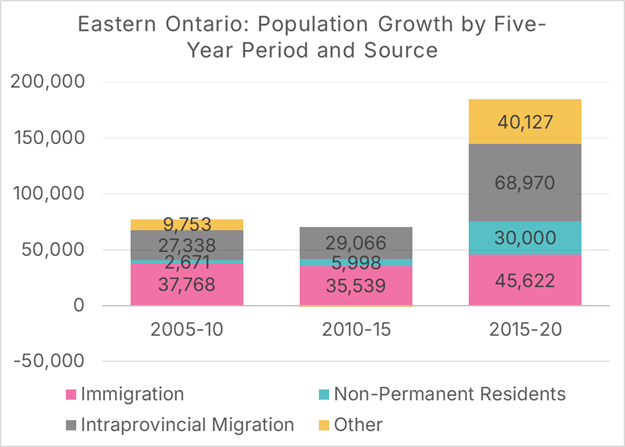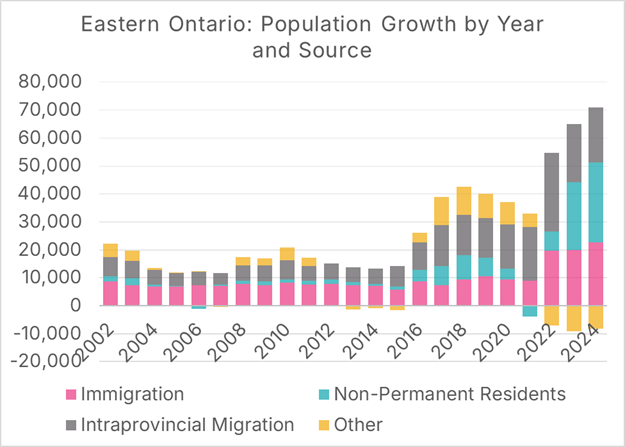Families on the Move: 670,000 More Households in Eastern Ontario by 2051
A new report from MMI
Highlights
A need to build 670,000 new homes: Taking into account migration patterns, we find that Eastern Ontario’s 15 census divisions must add 670,000 new homes between 2021 and 2051. Of these 670,000 homes, 495,000 ground-oriented homes are needed, along with 175,000 apartment units. This demand encompasses projected population growth, pre-existing shortages, and the increasing number of families relocating from the GTA, searching for a high-quality of life and a three (or more) bedroom, ground-oriented home they can afford to own.
A pre-existing shortage of 500,000 homes across Ontario: As of Census 2021, Ontario had a 500,000 shortage of homes, of which over 370,000 were ground-oriented.
The population has been growing faster than housing inventory: The lack of ground-oriented ownership housing is due to a combination of rapid population growth, low levels of ground-oriented housing construction, and conversion of ownership housing to rentals to support the increased population of newcomers to Canada.
Eastern Ontario’s rapid population growth: Eastern Ontario has experienced significant growth in recent years, driven by increased immigration, the influx of non-permanent residents, and families relocating from other parts of Ontario, resulting in a pressing need for more housing.
The drive until you qualify exodus contributing to Eastern Ontario population growth: The lack of ground-oriented housing is leading to an exodus of young families out of the GTA to Eastern Ontario and other parts of the province. This trend will not only continue, it will accelerate.
The Ministry of Finance's (MoF) population projections are underestimating Eastern Ontario’s future population growth. The MoF’s population projections do not adequately capture migration patterns from the GTA, resulting in an overestimation of future population growth in the GTA and an underestimation in Eastern Ontario. Relying on current MoF population projections will cause future housing shortages in Eastern Ontario.
Today, the Missing Middle Initiative released its report, “Families on the Move: 670,000 More Households” in Eastern Ontario by 2051. A full copy of the report can be downloaded at the bottom of the page.
Eastern Ontario’s need for more homes
Eastern Ontario began experiencing rapid population growth a decade ago, due to an increase in new immigrants to Canada settling in the area, growth in the non-permanent resident population, along with an increase in the number of families moving in from other parts of the province (known as intraprovincial migration), as shown in Figure 1.
Figure 1. Population growth by five-year period and source, Eastern Ontario
Data Sources: Statistics Canada table 17-10-0153-01 and Chart Source: MMI
This growth is expected to continue, with the Ontario Ministry of Finance projecting that Eastern Ontario’s population will increase by over one million between 2021 and 2051, with 900,000 of that growth occurring between 2024 and 2051. This population growth will create the need for hundreds of thousands of additional homes.
However, these estimates almost certainly underestimate the need. The Ministry’s projection that, from 2024 to 2051, the Region will grow, on average, by 33,000 persons, is almost certainly an underforecast.
While recent changes to immigration and non-permanent resident programs will reduce population growth from these sources, intraprovincial migration will continue to remain strong, and the Region’s relative affordability and high quality of life will attract an increasing number of new residents from other parts of the province.
Figure 2. Population growth by year and source, Eastern Ontario
Data Sources: Statistics Canada table 17-10-0153-01 and Chart Source: MMI
The drivers of housing demand and housing need in Eastern Ontario must be understood within a broader provincial context.
Eastern Ontario’s housing needs within a provincial context
Ontario needs more homes to house a growing number of families, with both the provincial and federal governments committing to doubling housing starts. However, different families have varying housing needs, with some requiring a small, cozy place to call home, while others need three or more bedrooms to support growing families with children. Canada’s National Housing Strategy Act (NHSA) acknowledges the diverse needs of families, emphasizing that homes must be affordable, adequate, and suitable for the size and composition of each family.
In short, a “housing unit is not a housing unit”. Ontario must not only ensure that enough homes are built, but also that there is a diversity of housing types to suit a diversity of housing needs.
To meet the standards set by the NHSA, families with children often require homes with three or more bedrooms, and these families have consistently moved into such homes. Homes with three bedrooms or more are typically found in “ground-oriented” forms of housing, such as single-detached, semi-detached, townhomes, and many (but not all) forms of “missing middle housing”. As of the 2021 Census, 88% of all ground-oriented homes occupied by their owners had three bedrooms or more, whereas only 10% of rental apartments contained this many bedrooms. The size differences between unit types help explain why nearly 80% of all couples with children live in a ground-oriented home that they own.
In the summer of 2025, the Greater Ottawa Home Builders’ Association approached the Missing Middle Initiative (MMIs) to create housing demand projections for Eastern Ontario through 2051. Initially, this appeared to be a straightforward exercise. Using MMI’s RoCA (Rest of Canada Average) Benchmark model and Census 2021 data, pre-existing housing surpluses and shortages were calculated at the census division level for four different forms of housing. To estimate future demand, the Ontario Ministry of Finance’s population projections from August 2025 were used to determine the number of homes that must be added from 2021 to 2051 to keep pace with demographic change.
After conducting this exercise, we found that the Greater Toronto Area, which we define in this report as the census divisions of York Region, Peel Region, Durham Region, and the City of Toronto, would need to add nearly one million ground-oriented homes between 2021 and 2051 to address pre-existing shortages and to keep pace with demographic change. Given that the Region has been adding approximately 10,000 of these homes each year, and given a lack of development land in the area, it would take the GTA nearly a century to add this many homes, if it were able to do so at all.
When there is a lack of these homes available, families, particularly young families with children or those planning to have children, often move out of the Region to find suitable housing that they can afford. This migration is exactly what has happened in recent years, as the net number of residents moving out of the GTA to other parts of the province increased from 118,000 in 2009-14 to 218,000 in 2014-19, and then to 359,000 in 2019-24. A high proportion of these “drive until you qualify” families ultimately relocate to communities in Eastern Ontario.
In short, it appears that the Ministry of Finance’s population projections are inadequately capturing the impact of persistent shortages of three-bedroom homes. As such, those projections overestimate future population growth in the GTA and underestimate it in the rest of Ontario.
Building from those results, this report tells a story in seven parts on the drivers of housing demand in Eastern Ontario, as follows:
Housing demand in Eastern Ontario – a story in seven parts
1. A shortage of 500,000 homes: As of Census 2021, Ontario’s housing shortage exceeded 500,000 homes.
2. A lack of family-sized homes in the GTA: This growing housing shortage is disproportionately prevalent in the GTA, particularly in ground-oriented ownership housing.
3. The population is growing faster than the housing inventory. The lack of ground-oriented ownership housing in the GTA is due to a combination of rapid population growth, low levels of ground-oriented housing construction, and the conversion of ownership housing to rentals.
4. The drive until you qualify exodus to Eastern Ontario: The lack of ground-oriented housing is leading to an exodus of young families out of the GTA to Eastern Ontario and other parts of the province.
5. The housing shortage extends beyond the GTA: The outmigration of families from the GTA is contributing to housing shortages in other parts of the province, including Eastern Ontario.
6. The GTA cannot build enough ground-oriented homes: The pre-existing shortage is too large, and the limitations are too great for the GTA to build enough ground-oriented homes to satisfy the needs of young, middle-class families. The “drive until you qualify” migration of young families with children will continue.
7. Eastern Ontario communities must plan for accelerated population growth. To address the existing shortage of homes and create enough to keep up with the Ministry of Finance population projections, planning is necessary, but it isn’t sufficient. Those population projections do not adequately capture the extent to which the shortage of family-friendly housing in the GTA will cause further outmigration to Eastern Ontario.
Using the RoCA Benchmark 3.0 methodology, we find that Eastern Ontario’s 15 census divisions must add 670,000 homes between 2021 and 2051 to address pre-existing shortages, keep up with population growth and demographic change, and address an increase in “drive until you qualify” families from the GTA. Of these 670,000 homes:
495,000 ground-oriented homes are needed, with 382,000 needed to keep pace with population growth and demographic change, 8,000 to address pre-existing shortages, and 105,000 to address “drive until you qualify” migration from the GTA.
An additional 175,000 apartment units are needed, with 148,000 required to keep pace with population growth and demographic changes, and 27,000 needed to address existing shortages.
To ensure that a sufficient quantity and diversity of homes are built, we conclude the report with the following five recommendations.
Recommendations to ensure an adequate and appropriate supply of housing in Eastern Ontario
The province of Ontario should release municipal housing supply targets differentiated by unit type, and these targets should be incorporated into the respective municipal Official Plans.
Municipal Official Plans must incorporate a margin of error, which allows for unexpectedly high population growth.
The Ministry of Finance’s population projection model should be adjusted to incorporate better “drive until you qualify” migration patterns.
All three orders of government should enact reforms to facilitate the construction of three-bedroom units and above in various housing forms.
The federal government should announce changes in immigration and non-permanent resident targets well in advance of those changes taking effect, allowing communities time to adjust.
To download the full report, click on the link below:




